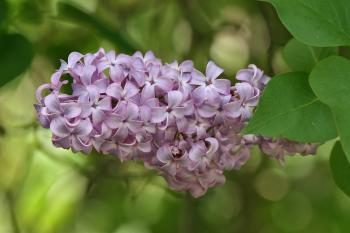November 3, 2018

Question:
I've got some spindly lilac bushes. Should I cut them back now or wait for spring? How can I make them grow fuller?
- Lisa W., Santa Fe
Answer:
Good news—you can wait even longer. For maximum flowering effect, keep your clippers in their scabbard until after the lilac flowers have senesced (faded). Lilac bushes bear flowers on last year’s growth, so if you prune in the late summer or fall when branch growth slows in preparation for dormancy, you’ll likely diminish—or extinguish—spring blooming. This is also true for other early spring bloomers, like forsythia and cherry trees.
In last week’s column we learned about the bearing habits of fruit trees and how stressful environmental events, like drought or typhoons, can trigger plants to flower at the wrong time. A friend from Wilmington, North Carolina told me this past weekend that many of the area’s dogwoods, redbuds, Bradford pears, and azaleas are blooming out of sync, and it’s being attributed to the stress that came with Hurricane Florence in September.
In addition to fruit trees blossoming in New Mexico, I’ve also received several reports from around the state from people whose lilacs were blooming in October. Drought stress is a likely culprit. Although this makes the second bloom this calendar year, it’s likely that those are next year’s flowers blooming early instead of the other way around.
So, if the lilac rule is to prune after blooming, is it okay then to prune the ones that bloomed for the second time this year, even if it’s November? Probably not.
If the goal is max bloom (at the “correct” time in spring), I wouldn’t prune now because there may be flowering buds along the branch that stayed dormant next to the ones that bloomed “late.” While you can cut back your lilac now to reduce the spindly look and encourage a fuller growth habit, you might be sacrificing spring color.
The healthiest way to maximize flowering potential and get a full, lush shrub is to grow healthy plants. To me, that means smart watering, a thick layer of fibrous mulch on the soil surface, shrewd pruning cuts, and very judicious fertilizer use. (I’m always worried about the dangers of increasing saltiness in our soils and tend to steer away from using conventional fertilizers in ornamental landscapes – a topic for another week.)
Enough beating around the bush! Back to pruning lilacs…
Flowering beauty aside, every pruning cut causes plant injury, so technique and timing are important. For plants that are entering dormancy, woody pruning cuts performed now are bad because the plant is not going to be able to develop new tissue to effectively seal off the wounds until growth starts back up in the spring. From the open wound perspective, the best time to prune many plants is late winter or early spring when growth really kicks off. In plants that do not truly go dormant, like roses, or plants that aren’t yet entering dormancy, pruning right now can actually encourage a flush of new growth that will be especially tender and susceptible to freeze injury in the coming months.
For more info on proper pruning techniques, including a method for dealing with straggly, overgrown shrubbery called rejuvenation pruning, visit Desert Blooms this week, or just wait to dig out your pruning shears until I remind you in March.
Marisa Y. Thompson, PhD, is the Extension Horticulture Specialist, in the Department of Extension Plant Sciences at the New Mexico State University Los Lunas Agricultural Science Center, email: desertblooms@nmsu.edu, office: 505-865-7340, ext. 113.
Links:
For more gardening information, visit the NMSU Extension Horticulture page at Desert Blooms and the NMSU Horticulture Publications page.
Send gardening questions to Southwest Yard and Garden - Attn: Dr. Marisa Thompson at desertblooms@nmsu.edu, or at the Desert Blooms Facebook page.
Please copy your County Extension Agent and indicate your county of residence when you submit your question!